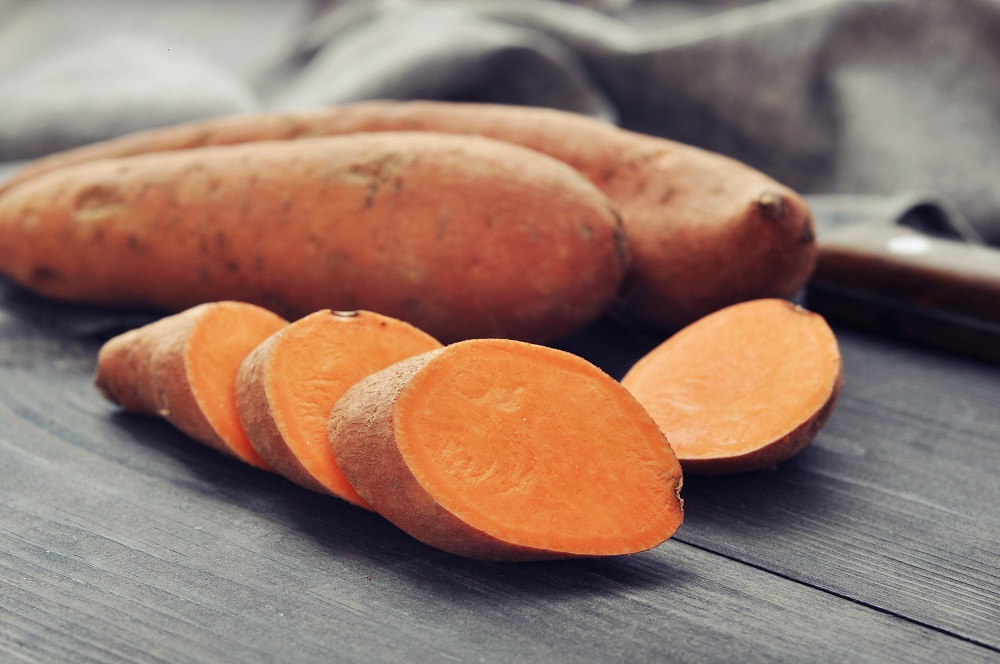Sweet potatoes are one of the healthiest and most nutritious plants on the planet! This starchy vegetable is an excellent source of antioxidants and disease-fighting phytochemicals with many health benefits. Sweet potatoes are a nutrient-dense food that will help you stay fuller longer. It’s one of the cheapest superfoods that will protect you against developing a chronic illness (1,2).
In this article, you will learn all about the benefits of sweet potato for your health with tips how to optimize its healing power.
The power of sweet potato
Sweet potatoes are natural unrefined carbohydrates packed with vitamins, minerals and disease fighting phytochemicals. They are known as an excellent source of Vitamin C, Vitamin E, Vitamin B6, potassium and fibre while being low in saturated fat and cholesterol.
This high nutritional content of sweet potato makes them a high-quality carbohydrate, optimal energy source for your muscle cells and brain and an excellent choice for cancer prevention, healthy weight loss, blood sugar control, hormonal balance and gut health (1,2,3).
Antioxidant power
Sweet potato contains a variety of phytochemicals including phenolic acid (polyphenols) and carotenoids (e.g beta-carotene), flavonoids and anthocyanins. All these compounds are strong antioxidants that prevent cellular damage and have anti-inflammatory and anti-cancer effects for your body (4,6).
Polyphenols work as antioxidants against free radicals to prevent cellular damage and also has anti-inflammatory effects in the body.
Carotenoids such as beta-carotene have powerful antioxidant and anticancer activity, critical for cancer-prevention, brain health, eye-health and heart health.
Anthocyanins are compounds with strong anticancer activity, promoting programmed cell death of cancer cells and have strong anti-aging effects for your body.
The sweet potato peel contains the antioxidant power comparable to wild blueberries.
Michael Greger MD, How not to die Tweet
Phyto-estrogenic power
Sweet potato is a good source of phytoestrogen called matairesinol that has protective effects against developing hormone-dependent cancers such as breast cancer and prostate cancer. The high levels of hormone estrogen are linked to higher chances of developing cancer and other chronic illnesses such as endometriosis in woman. Phytoestrogens in sweet potato act as natural regulators of estrogen, blocking the negative effect of estrogen on human body and reducing the change of developing hormone-dependent disease (5).
Starchy power
Sweet potato is a starchy root vegetable that contains dietary fibre and resistance starch. Both fibre and resistance starch resist the digestion in the small intestine and ferment in the large intestine. During the fermentation process, they both act as a prebiotic food feeding the good bacteria in the gut and as result improving digestion.
At the same time, fibre and resistance starch act as a probiotic food. The good bacteria in the intestine break down some of the resistant starch and fibre into beneficial compounds that are digested back into the body, improving the immune system and reducing cancer risk (7).
Other benefits include increased feeling of fullness, treatment and prevention of constipation, lowering cholesterol levels, better blood sugar control and reducing your risk to develop colon cancer (2).
The power of unrefined carbohydrates
Our bodies are designed to run on carbohydrates. Carbohydrates are an essential source of energy and vital nutrients for our cells, particularly the brain that needs glucose for functioning.
When you consume carbohydrates in their natural unrefined state, you are eating a perfect package of important nutrients that are designed to maintain your ideal weight (3). In contrast, processed carbohydrates are empty calories that include processed fats, sugars and oils, making your body prone to developing disease.
How to optimise their power?
The goodness is in the skin
The skin of the sweet potato is the most nutritious part of this vegetable. Most of the disease-fighting nutrients in sweet potato are close to its skin, containing nearly ten times the antioxidant power of the inner flesh. This means the antioxidant power of the peel is comparable to wild blueberries (1).
This is why it’s best not to peel the sweet potato before cooking. Always make sure to wash the skin to remove any excess dirt and pesticides. The best method is to use a vegetable brush and rub the skin under running water.
You can also consider buying organic sweet potato to be certain that there is no residue pesticide left on the skin.
More colour more power
The colour of sweet potato is an important indicator of the amount of disease-fighting nutrients. More yellow or orange is the flesh, the more nutrients the sweet potato contains (1).
In addition, not all varieties of sweet potato contain the same amounts of disease-fighting phytochemicals. For example, sweet potato with orange flesh is richer in beta-carotene while sweet potatoes with purple flesh contain more anthocyanins (1).
When shopping for sweet potato, experiment with different varieties – they all have their unique powers, and remember the power is in the colour!
Eating tips and cooking hacks
The nutritional content of sweet potato depends on the cooking method you choose. Raw sweet potatoes have higher nutritional content than cooked sweet potatoes. However, boiling sweet potato makes nutrients such beta-carotene more absorbable. When cooking sweet potato, steaming preserves more nutrients than boiling and boiling is better than baking.
Recipe Ideas
Raw sweet potatoes are a delicious snack. Slice them up into a sticks and dip them into hummus.
If you like big salads, steamed or baked potatoes cut up into cubes is a great topping that will keep you fuller longer. Use raw leafy vegetables as the base for the salad or try this roast veggies quinoa dinner party salad.
Craving chips? Cut sweet potatoes into chips or wedges, spray them lightly with olive oil and bake them in the oven. It’s a delicious treat.
Not many people know that sweet potato is also a great base ingredient for healthy sweet potato pizza and for making a healthy brownie. Give it a try and you won’t regret.
There is no doubt that sweet potato is a powerful vegetable with many healing properties and it’s so versatile too! Try to eat sweet potato in any form at least 3 times a week to make the most of its benefits for your health.
References
- Richard Beliveau, Denis Gingras, Foods to fight cancer second edition, 2017, London, UK
- Australian Mushrooms, 2021, https://australianmushrooms.com.au/health/
- Pellegrini N, et al. Total antioxidant capacity of plant foods, beverages and oils consumed in Italy assessed by three different in vitro assays. J Nutrition 2003; 133: 2812-2819 https://academic.oup.com/jn/article/133/9/2812/4688193
- Kalaras MD et al Mushrooms: A rich source of the antioxidants ergothioneine and glutathione. Food Chem. 2017 Oct 15;233:429-433. doi: 10.1016/j.foodchem.2017.04.109. https://www.ncbi.nlm.nih.gov/pubmed/28530594
- Michael Greger M.D., How not to die, 2015, London, UK.
- Chris Wark, Chris Beat Cancer, 2018, Hay House, USA








